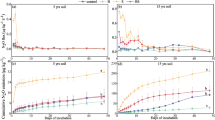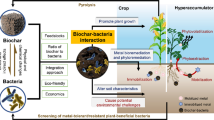Abstract
Purpose
Bacteria able to extracelluar respiration, which could be enriched in the anode of microbial fuel cells (MFCs), play important roles in dissimilatory iron reduction and arsenic (As) desorption in paddy soils. However, the response of the bacteria to As pollution is unknown.
Materials and methods
Using soil MFCs to investigate the effects of As on anode respiring bacteria (ARB) communities in paddy soils exposed to As stress. The soil MFC performances were evaluated by electrochemical methods. The bacterial community compositions on anodes were studied using Illumina sequencing.
Results and discussion
In wet 1 phase, polarization curves of MFCs showed cathode potentials were enhanced at low As exposure but inhibited at high As exposure. In the meantime, anode potentials increased with As levels. The dry-wet alternation reduced As levels in porewater and their impacts on electrodes microorganisms. Arsenic addition significantly influenced the anode microbial communities. After dry-wet cycles, Deltaproteobacteria dominated in the anode with high As.
Conclusions
The dynamic changes of the communities on cathodes and anodes of soil MFCs in paddy soils with different As addition might be explained by their different mechanisms for As detoxification. These results provide new insights into the microbial evolution in As-contaminated paddy soils.





Similar content being viewed by others
References
Caporaso JG, Kuczynski J, Stombaugh J, Bittinger K, Bushman FD, Costello EK, Fierer N, Pena AG, Goodrich JK, Gordon JI, Huttley GA, Kelley ST, Knights D, Koenig JE, Ley RE, Lozupone CA, McDonald D, Muegge BD, Pirrung M, Reeder J, Sevinsky JR, Turnbaugh PJ, Walters WA, Widmann J, Yatsunenko T, Zaneveld J, Knight R (2010) QIIME allows integration and analysis of high-throughput community sequencing data. Nat Methods 7:335–336
Dunaj SJ, Vallino JJ, Hines ME, Gay M, Kobyljanec C, Rooney-Varga JN (2012) Relationships between soil organic matter, nutrients, bacterial community structure, and the performance of microbial fuel cells. Environ Sci Technol 46(3):1914–1922
Edvantoro BB, Naidu R, Megharaj M, Singleton I (2003) Changes in microbial properties associated with long-term arsenic and DDT contaminated soils at disused cattle dip sites. Ecotoxicol Environ Saf 55(3):344–351
Giloteaux L, Holmes DE, Williams KH, Wrighton KC, Wilkins MJ, Montgomery AP, Smith JA, Orellana R, Thompson CA, Roper TJ (2012) Characterization and transcription of arsenic respiration and resistance genes during in situ uranium bioremediation. ISME J 7(2):370–383
Gomez E, Durillon C, Rofes G, Picot B (1999) Phosphate adsorption and release from sediments of brackish lagoons: pH, O2 and loading influence. Water Res 33(10):2437–2447
Hery M, Gault AG, Rowland HAL, Lear G, Polya DA, Lloyd JR (2008) Molecular and cultivation-dependent analysis of metal-reducing bacteria implicated in arsenic mobilisation in south-east asian aquifers. Appl Geochem 23(11):3215–3223
Hery M, Van Dongen BE, Gill F, Mondal D, Vaughan DJ, Pancost RD, Polya DA, Lloyd JR (2010) Arsenic release and attenuation in low organic carbon aquifer sediments from West Bengal. Geobiology 8(2):155–168
Huang B, Li Z, Huang J, Chen G, Nie X, Ma W, Yao H, Zhen J, Zeng G (2015) Aging effect on the leaching behavior of heavy metals (Cu, Zn, and Cd) in red paddy soil. Environ Sci Pollut Res 22(15):11467–11477
Husson O (2013) Redox potential (Eh) and pH as drivers of soil/plant/microorganism systems: a transdisciplinary overview pointing to integrative opportunities for agronomy. Plant Soil 362(1–2):389–417
Islam FS, Pederick RL, Gault AG, Adams LK, Polya DA, Charnock JM, Lloyd JR (2005) Interactions between the Fe(III)-reducing bacterium Geobacter sulfurreducens and arsenate, and capture of the metalloid by biogenic Fe(II). Appl Environ Microbiol 71(12):8642–8648
Jalali M, Khanlari ZV (2008) Effect of aging process on the fractionation of heavy metals in some calcareous soil of Iran. Geoderma 143(1–2):26–40
Jia Y, Huang H, Zhong M, Wang FH, Zhang LM, Zhu YG (2013) Microbial arsenic methylation in soil and rice rhizosphere. Environ Sci Technol 47(7):3141–3148
Lear G, Song B, Gault AG, Polya DA, Lloyd JR (2007) Molecular analysis of arsenate-reducing bacteria within Cambodian sediments following amendment with acetate. Appl Environ Microbiol 73(4):1041–1048
Li R, Stroud J, Ma J, McGrath S, Zhao F (2009) Mitigation of arsenic accumulation in rice with water management and silicon fertilization. Environ Sci Technol 43(10):3778–3783
Li G, Sun GX, Williams PN, Nunes L, Zhu YG (2011) Inorganic arsenic in Chinese food and its cancer risk. Environ Int 37(7):1219–1225
Logan BE, Regan JM (2006) Electricity-producing bacterial communities in microbial fuel cells. Trends Microbiol 14(12):512–518
Lorenz N, Hintemann T, Kramarewa T, Katayama A, Yasuta T, Marschner P, Kandeler E (2006) Response of microbial activity and microbial community composition in soils to long-term arsenic and cadmium exposure. Soil Biol Biochem 38(6):1430–1437
Lovley DR (2008) Extracellular electron transfer: wires, capacitors, iron lungs, and more. Geobiology 6(3):225–231
Lovley DR, Holmes DE, Nevin KP (2004) Dissimilatory Fe(III) and Mn(IV) reduction. Adv Microb Physiol 49:219–286
Marin A, Masscheleyn P, Patrick W Jr (1993) Soil redox-pH stability of arsenic species and its influence on arsenic uptake by rice. Plant Soil 152(2):245–253
Masscheleyn PH, Delaune RD, Patrick WH (1991) Effect of redox potential and pH on arsenic speciation and solubility in a contaminated soil. Environ Sci Technol 25:1414–1419
Meliker JR, Franzblau A, Slotnick MJ, Nriagu JO (2006) Major contributors to inorganic arsenic intake in southeastern Michigan. Int J Hyg Envir Heal 209(5):399–411
Miceli JF III, Parameswaran P, Kang DW, Krajmalnik Brown R, Torres CI (2012) Enrichment and analysis of anode-respiring bacteria from diverse anaerobic inocula. Environ Sci Technol 46(18):10349–10355
Ohtsuka T, Yamaguchi N, Makino T, Sakurai K, Kimura K, Kudo K, Homma E, Dong DT, Amachi S (2013) Arsenic dissolution from Japanese paddy soil by a dissimilatory arsenate-reducing bacterium Geobacter sp. OR-1. Environ Sci Technol 47(12):6263–6271
Oremland RS, Stolz JF (2003) The ecology of arsenic. Science 300(5621):939–944
Paez-Espino D, Tamames J, de Lorenzo V, Cánovas D (2009) Microbial responses to environmental arsenic. Biometals 22(1):117–130
Sun GX, Williams PN, Zhu YG, Deacon C, Carey AM, Raab A, Feldmann J, Meharg AA (2009) Survey of arsenic and its speciation in rice products such as breakfast cereals, rice crackers and Japanese rice condiments. Environ Int 35(3):473–475
Takahashi Y, Minamikawa R, Hattori KH, Kurishima K, Kihou N, Yuita K (2004) Arsenic behavior in paddy fields during the cycle of flooded and non-flooded periods. Environ Sci Technol 38(4):1038–1044
Tang XY, Zhu YG, Shan XQ, McLaren R, Duan J (2007) The ageing effect on the bioaccessibility and fractionation of arsenic in soils from China. Chemosphere 66(7):1183–1190
Upadhyaya G, Clancy TM, Brown J, Hayes KF, Raskin L (2012) Optimization of arsenic removal water treatment system through characterization of terminal electron accepting processes. Environ Sci Technol 46(21):11702–11709
Wang XJ, Chen XP, Yang J, Wang ZS, Sun GX (2009) Effect of microbial mediated iron plaque reduction on arsenic mobility in paddy soil. J Environ Sci 21(11):1562–1568
Wang N, Chen Z, Li HB, Su JQ, Zhao F, Zhu YG (2015) Bacterial community composition at anodes of microbial fuel cells for paddy soils: the effects of soil properties. J Soils Sediments 15(4):926–936
Weldon JM, MacRae JD (2006) Correlations between arsenic in Maine groundwater and microbial populations as determined by fluorescence in situ hybridization. Chemosphere 63(3):440–448
Williams PN, Islam MR, Adomako EE, Raab A, Hossain SA, Zhu YG, Feldmann J, Meharg AA (2006) Increase in rice grain arsenic for regions of Bangladesh irrigating paddies with elevated arsenic in groundwaters. Environ Sci Technol 40(16):4903–4908
Xu XY, McGrath SP, Meharg AA, Zhao FJ (2008) Growing rice aerobically markedly decreases arsenic accumulation. Environ Sci Technol 42(15):5574–5579
Zhu YG, Sun GX, Lei M, Teng M, Liu YX, Chen NC, Wang LH, Carey AM, Deacon C, Raab A, Meharg AA, Williams PN (2008a) High percentage inorganic arsenic content of mining impacted and nonimpacted Chinese rice. Environ Sci Technol 42(13):5008–5013
Zhu YG, Williams PN, Meharg AA (2008b) Exposure to inorganic arsenic from rice: a global health issue? Environ Pollut 154(2):169–171
Zhu YG, Yoshinaga M, Zhao FJ, Rosen BP (2014) Earth abides arsenic biotransformations. Annu Rev Earth Planet Sci 42(1):443–467
Acknowledgments
The work is financially supported by the National Natural Science Foundation of China (No. 41430858 and 41571305) and the Natural Science Fund for Colleges and Universities of Jiangsu Province (15KJB610014).
Author information
Authors and Affiliations
Corresponding authors
Ethics declarations
Conflict of interest
The authors declare that they have no competing interests.
Human and animal rights and informed consent
This article does not contain any studies with animals or human participants performed by any of the authors. Informed consent was obtained from all individual participants included in the study.
Additional information
Responsible editor: Galina Machulla
Electronic supplementary material
Below is the link to the electronic supplementary material.
ESM 1
(DOC 5175 kb)
Rights and permissions
About this article
Cite this article
Wang, YJ., Chen, Z., Liu, PP. et al. Arsenic modulates the composition of anode-respiring bacterial community during dry-wet cycles in paddy soils. J Soils Sediments 16, 1745–1753 (2016). https://doi.org/10.1007/s11368-016-1369-6
Received:
Accepted:
Published:
Issue Date:
DOI: https://doi.org/10.1007/s11368-016-1369-6




